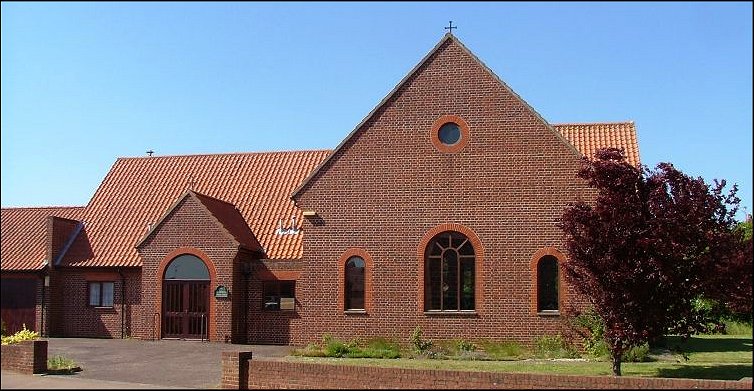| |
|
St
Cecilia, Dersingham
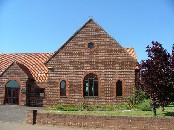 |
|
This Catholic church is
the story of what one woman's patience can
endure, and what her resolution can achieve. It
sits on a modern housing estate, but actually
only yards from Dersingham's high street, a
handsome red brick building with ecclesiological
features but otherwise solidly in a Norfolk rural
vernacular. Dersingham
is part of the suburban sprawl to the north of
the Sandringham estate, now happily bypassed. It
runs into Ingoldisthorpe and then Snettisham, but
all three have characters of their own, and
Dersingham is the most town-like. Sandringham
itself merges into the village, and as you leave
the Anglican parish church of St Nicholas on its
rise to the east, you are soon among the
rhododendron-lined lanes of the estate.
|
St Cecilia
is the more central of the two main churches, and with
its modern facilities it is regularly in use by local
secular community groups. Not long after we arrived to
take our photographs, we were lucky that Deacon Len
turned up. He lives in the house beside the church, and
was happy to show us around.
The
eastern part of the building forms the actual church, a
rectangle sat end-on to the road. The sanctuary is set
within the eastern wall, a traditional position but
actually within the longest wall here, and so creating,
in effect, a church in the half-round. There are lancet
windows at the northern end, and arched windows filled
with coloured glass at the southern end. Tracking in the
ceiling allows the sanctuary to be screened off when the
room is used for secular purposes, although Deacon Len
tells us that the statue of Our Lady is never removed.
There is
also a track enabling the entire room to be split into
two, so that one side can be used by groups while Mass is
in progress, although Deacon Len says that, in practice,
this doesn't happen; too much noise leaks through the
partition. To the west are offices, kitchens, toilets and
meeting rooms. At the other end of the complex is the
Deacon's house, like a presbytery.
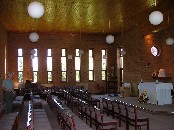
 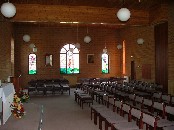
Although
the building is traditional in style, it contains all the
modern facilities you can think of. Of course, the
medieval St Nicholas up on the hill was a Catholic church
before the Reformation, but after the long penal years it
was not until 1992 that the Catholic Church returned to
having this permanent home in Dersingham. From the middle
of the 19th century Dersingham was in the vast Kings Lynn
parish, and then from the 20th century in the new parish
of Hunstanton.
There was
no local Mass centre, and Hunstanton is is some nine
miles away, and it so happened that a local Catholic
woman who cycled to Mass every Sunday decided that other
Dersingham residents should not suffer the same
inconvenience as herself. Deacon Len told us the
heart-warming story. It seems that when the lady in
question retired, she decided to keep herself busy by
playing the stock market.
| By
the time she died, she had amassed an impressive
£300,000. In her will, this was left to the
Diocese of East Anglia, but on the singular
condition that it must be used within ten years
to build a Catholic church in Dersingham. If this
did not happen, the money would revert to the
estate and be split ten ways for different
charities. The Diocese accepted the
money and its conditions, and then took nearly
ten years to decide to build the church. In that
time, the money had gained interest, and so it
was that almost £400,000 was available to build
what is actually just a chapel of ease, but a
finer building than some parish churches in the
Diocese. Perhaps one day, it might even achieve
that status. It would certainly be ready for it.
|
|
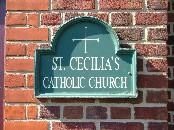 |
Simon Knott, June 2006
|
|
|

